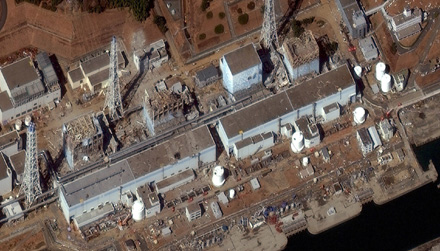Tokyo (Xinhua): An end to the nuclear accident caused by the March 11 earthquake and tsunami in northeastern Japan seems out of reach still for a while, as a high level of radioactivity was detected at a reactor in the troubled Fukushima No. 1 nuclear power plant on Sunday.
High Radioactivity
More than 1,000 millisieverts per hour was found Sunday in the water at No. 2 reactor — 10 million times the radioactivity level when the reactor is operating normally, and the contaminated water is believed to come from the damaged fuel in the reactor.
Japanese authorities also found that radioactive iodine-134 was extremely high in water at the reactor, and those working at the reactor were temporarily evacuated.
Radioactive iodine which is 1,850 times the legal limit was found in sea near the troubled plant, according to Kyodo. The level had surpassed the figure detected near the drain outlets of the plant Saturday, when the government’s Nuclear and Industrial Safety Agency found radioactive iodine 1,250.8 times above legal limit in sea near the plant.
But there are also reports showing that a Tokyo Electric Power Co. spokesperson said Sunday night that readings showing the increased radioactivity were “not credible.”
 According to the National Police Agency, the March 11 catastrophe has left 10,668 people dead and 16,574 others unaccounted for in Japan by 15:00 p.m. local time (0600 GMT) Sunday.
According to the National Police Agency, the March 11 catastrophe has left 10,668 people dead and 16,574 others unaccounted for in Japan by 15:00 p.m. local time (0600 GMT) Sunday.
No Need to Worry for Others
As radioactive particles coming from the Fukushima nuclear power plant have been reportedly detected in as far away as China, the U.S. west coast and even Iceland, Jeffrey Merrifield, former commissioner of the U.S. Nuclear Regulatory Commission (NRC), told Xinhua that there is no need yet to worry.
“Whether you are in the United States or for that matter in China, I don’t think there will be serious consequence from the radiation from Fukushima.”
During his tenure as commissioner, Merrifield visited more than half of the world’s 440 operating nuclear units, including those in Fukushima. He thought obviously there will be a small amount of radioactivity spreading beyond Japan, but these are “in very low levels” and “will not impact public health.”
“Most of the radiation will be localized in the areas around the site (in Fukushima) and in Japan. Some of that radioactive material that did blow to the east over the Pacific Ocean will be diluted as a result of the wind and exposure to the ocean water,” he said.
Merrifield meanwhile thought those plants that are being designed or underway, both in the United States and elsewhere, are safer than the plant in Fukushima.
On Sunday, the Chinese Center for Disease Control and Prevention (CDC) said the low levels of radioactive iodine-131 detected in the air above China’s northeastern Heilongjiang Province do not pose a threat to public health.
No protective measures are needed as the levels of detected iodine-131 are very low and do not pose a threat, the CDC said in a statement.
The discovery of the radioactive material is a sign that some radioactive material released from Japan’s crippled nuclear power plant has reached China, but it will not affect public health, the CDC said.
The committee said the detected levels of iodine-131 were below one-hundred-thousandth of the average annual exposure level and were not considered to be harmful.






















